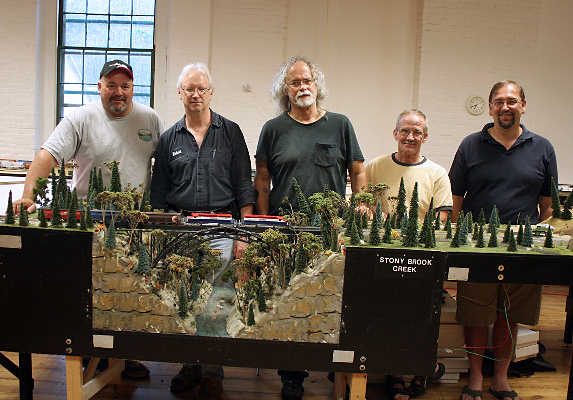Railroad club engineers in miniature

Some children get model trains as Christmas or birthday gifts, then pack them away when they get older.
As some kids grow up, however, their hobby grows with them.
No figure-eight track in the living room for these guys.
Members of the Wachusett Model Railroad Club take their hobby seriously, with train and scenario modules that are installed in layouts that take up hundreds of square feet.
The local club, started in January 2010, has about a dozen members and space in the old Bigelow Carpet Mill on Main Street.
Members originally met one another through the Leominster hobby store where they get many of their components, eventually locating in space made available after several did work for owner Dean Weeks.
The larger space allows layouts, or modules, to remain set up.
“It's easier to work on,” Brian Kleinknecht said of the so-called HO-scale layouts, which is the most popular size of model railroads.
The modules can be removed or connected, and using standards adopted by all clubs, they can easily be added to others layouts such as one built at the Big E in Springfield every January. That 90-by-72-foot layout uses 96 modules; it takes 40 minutes to run a train through the entire loop at scale speed, Mike Cormier said.
Members have a passion for their hobby.
“I got a train set for my birthday, and as I got older I just kept doing it,” Kleinknecht said. He said it is enjoyable, especially when he sees the reactions of kids at open houses.
Member Pat Varley even does model railroad work professionally. But for most it is a hobby that allows them to be creative.
Designs reflect personal preferences, Flanders said, including backgrounds such as industrial or residential areas.
Many are not built from kits, he said, but from scratch using materials such as plaster.
There are hundreds of kits available, Ted Whitney said, “But then we use the extra parts – kit mashing – to build something new from the parts.”
Whitney is working on recreating an actual area of the Fitchburg past, when Crocker manufacturing was active.
Others reproduce “fallen flags, old rail lines like the Central Mass Railway,” Kleinknecht said. “The whole idea of modeling, it's all in your imagination.”
“It's always a work in progress,” Flanders added.
“New members add their parts in,” Whitney said, contributing to the larger layout.
“When you think you're done, you tear it apart and do more,” Cormier said.
The setup can be wireless, allowing members to more easily walk along with their trains, Cormier said, although many are tethered by lines, especially when multiple setups are working, which can lead to frequency conflicts.
The club plans an open house on Sept 18 from 9 a.m. to 3 p.m. Kleinknecht said donations will be accepted, which will go to the Item Appeal. The last open house had over 50 people attend, he said. The open house will be at 370R Main St, Unit 25.
The club's website is wmrrc.com.

